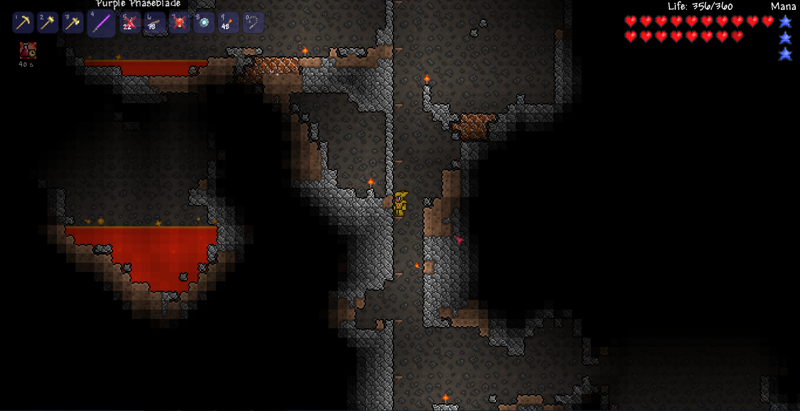First Impressions: Terraria
Terraria. Re-logic games May 16, 2011.
I came to Terraria, as I expect many readers did, because it was called the "2D Minecraft." The comparison is a fair one, although each game emphasizes a different aspect of the composite design they share. Minecraft is most definitely about building and accomplishment, with action thrown in to make it more interesting. Terraria is most definitely about action, fighting, getting better gear, etc. Building is an important part of it, but I found my buildings in Terraria tended to be much more Spartan and pragmatic than beautiful.
Terraria distinguishes itself from its predecessor on a much larger roster of craftable items, real and strenuous challenges in combat gameplay, and a number of markedly different underground zones that keep the game feeling fresh.
RECONSTRUCTIBLE TERRAIN
The biggest difference from Minecraft, at the outset, is Terraria's choice of a 2D randomly-generated reconstructible world. The change that this effects is that the game becomes a platformer. Naturally, the players have to construct most of the platforms, but there's no escaping the jumping mechanics inherent in a platform game. And there's no escaping the player's inherent desire to platform in a world that looks like it should bear it. It is engrained in a gamer's mind that 2D castles and dungeons should allow for jumping. And so you can!

Terraria is a much more directional game than its 3D counterpart as well. Lateral travel is more or less standard action/platform. There are biomes and interesting things to see on either side of the spawn/base, but it's clear that most of the content lies in the depths below--not that getting there will be easy. Safe descent into the bulk of the game's underground content requires careful manipulation of the varying subterrain that lies between your home on the surface, and the spoils of the depths. Stairs and platform-style ladders are essential. But even more important is the ability to plug and drain lakes, lava pools, and other natural hazards. All of this requires an engineering cleverness and copious use of reconstructible blocks mined out on the way down.
TOTAL TOOL CRAFTING
Terraria separates itself from its obvious forebear through its item system just as much as its reliance on more combat. The roster of craftable items is truly enormous, requiring a host of various workbenches to create. Indeed, most of the action of the game is driven by the pursuit of an ever-growing arsenal. Especially useful is the upgradable mining pick, which starts off as you would expect, and becomes a veritable mole machine at maximum strength. For weapons, the player can pick from swords, axes, flails, guns, bows, boomerangs, shuriken and explosives. All of those items come in varities of increasing strength, each of which must be crafted separately. To give you an idea about the depth, there are 12 levels of sword alone. Not every item in the same class is exactly alike; sometimes it comes down to preference and that's a good thing.
The only complaint about this system, although it is a big one, is that getting the best practical items can be a long uphill battle. Many accomplished Terraria players have excused themselves from playing because they "just can't go through the grind again." Of course the game isn't very old, and with new content out all the time this claim of fatigue will be tested and probably overcome more than once.
SUMMON ENEMIES
Although not terribly fleshed out yet, the bosses in Terraria operate mostly on a summon basis. Players find items which can call a boss monster, use them when and where they choose, and then fight. More than one Youtube uploader has shown how with the right building placement, these fights can be much more tactical than simple hack-and-slash. As of now there are only three bosses, two of which players can summon, but it's a promising concept. Especially in combination with the ability to alter the landscape, these bosses could be a very interesting mix of architecture and action.
DIRECTIONAL DIFFICULTY
The direction of the game is most definitely downward. Not every piece of content takes place deep underground, but most of it does. Although the bosses can be fought mostly anywhere, the items to summon them are in the ground. Most of the surface content like, like enemy-spawning meteor impacts, only take place once the right items have been refined out of mined-out deposits. The downward plunge is part of what makes Terraria more game-like than Minecraft. Hitting the bottom of the world is a very engaging goal, even if it doesn't wrap the game up, so to speak.
There are several discrete depth zones that make up the underworld of the game. The deeper you go, the more challenge you'll face, and the harder it is to get back there. Breaking through to a new difficulty zone is usually haphazard and alarming the first time it happens. It's not simply enemies that make these zones game difficult. Drowning in water and incineration in lava are both real dangers, especially when vast lakes of both lie between you and the richer zones. The bottom zone of the world is on fire all the time, and requires special items to navigate, all other (significant) challenges aside.
CONCLUSION
It is my sincerest hope--and I think it is very likely--that Minecraft and Terraria will compete with one another. In competition, they will be forced to emulate each others' game design ideas, to improve upon them, and to innovate. In this case, we gamers will benefit immensely from a competitive market, and for once everyone can benefit from the dreaded spectre of imitative designs.